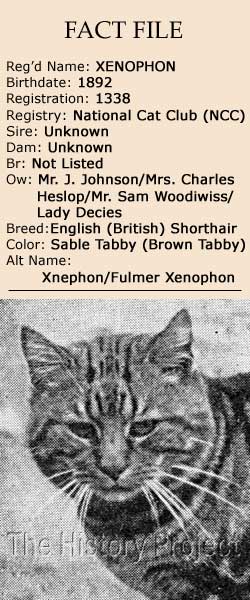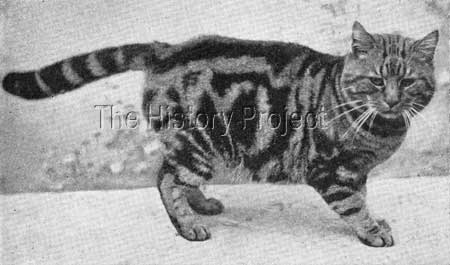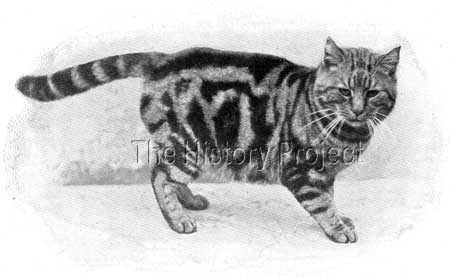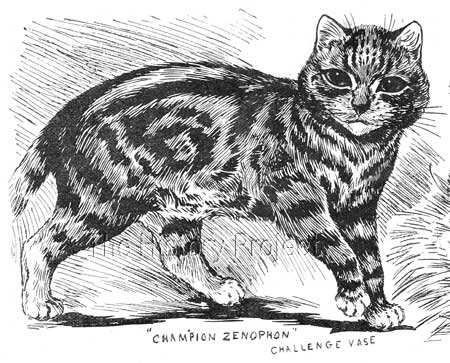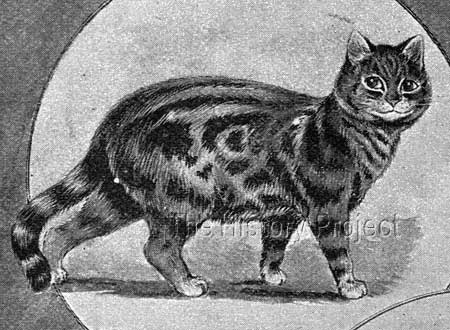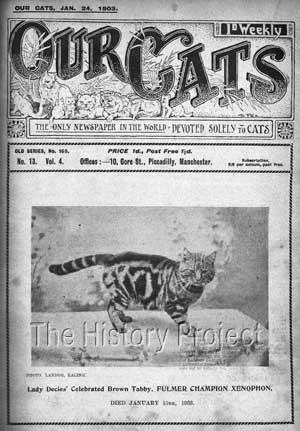 | ||||||||||||||||||||









|
XENOPHON (1892)PHOTOS | SOCIAL MEDIA | REFERENCES
HISTORICAL BACKGROUND:Of the many beautiful English shorthairs shown in the first 40 years of the Fancy, Ch. Xenophon was notably the most famous and the most honoured, with the only other shorthair cats to come close to him being the renowned Silver Tabbies 'Ch. Jimmy' owned by Mrs. Herring, and in his turn, the son of 'Jimmy', 'James II', owned by Mrs. Collingwood. On the show bench, 'Xenophon' was never defeated in his class and often took Best of Colour, Best in Variety, followed by Best Shorthair Cat, and on occasion, Best Cat in Show. Amongst the favoured Longhairs, his fiercest rival for top honours was the memorable multiple Best in Show winning chinchilla, 'Zaida'. For a time, both these very celebrated and amazing cats were owned and exhibited by Lady Gertrude Decies, with both becoming world-famous. During his lifetime, 'Xenophon' changed hands several times, twice due to the untimely demise of his then current owner. While he was owned by Mr. Charles Heslop, he was sometimes agented at the London shows by Mr. Charles Lane, amongst others, and it is a testament to the style and personality of the cat that he had such a large personal following of fans within the cat fancy. The following tribute to him is taken from Frances Simpson's The Book of The Cat, Chapter XXV, which dealt with shorthaired cats in particular. The writer bemoans the difficulty that breeders of Brown Tabbies experienced in seeking a good rich brown sable colour: "Very few good brown tabbies are benched, and breeders, I am afraid, get very disheartened at the result of their efforts. I despair to think of the litters I have seen, and not a good one amongst them. The rich brown sable colour is very seldom met with, and now that the world-renowned champion of champions, 'Xenophon,' is no more, we have only 'Flying Fox' and 'King of Lee' anything like the type you can expect in this handsome breed. 'Of Champion Xenophon' I am afraid we can truly say, 'We shall ne'er look on his like again.' His wonderful colour, markings, and size approached the ideal shorthair cat."4 In all his years as a show cat, Xenophon accumulated a staggering number of awards, making him the number one shorthaired cat of his era, of all shorthaired breeds and all colours. PARENTAGE & OWNERSHIP:'Ch. Xenophon' appears in the Register of The National Cat Club a number of times, but his initial registration was under the number (1338) in Vol.II of the Studbook, (January 1893 to March 1894). Here, he was already listed as a Champion, with Sire and Dam as 'unknown'. In this record his name is officially recorded as XNEPHON, with his first owner of record being Mr. J. Johnson, Lewisham, Malton, Yorkshire. His current owner was recorded as Mrs. Charles Heslop, of 24 Bondgate, Darlington, but at the bottom of the entry, there is also a rider which states: *Now owned by Mr. Sam Woodiwiss, Sedgemere, East Finchley.8 At this time, Mr. Sam Woodiwiss was an active Committee Member of The National Cat Club, and a friend of Mr. Charles H. Lane.
Unknown
Unknown
| Unknown
Xenophon, 1892, Brown Tabby English (British) SH, M
| Unknown
Unknown
Unknown
We can turn to Charles Lane's reminiscences published in Rabbits, Cats & Cavies in 1903, in which he tells of how he nearly owned 'Ch. Xenophon', for further information on how this lovely cat managed to change hands and slip through his fingers into the appreciative hands of Lady Gertrude Decies: "I think the best Brown Tabby that has been brought out for many years was the late Champion Xenophon, the property of Lady Decies, and I have always thought I did a foolish thing in refusing the offer of him, long before her ladyship ever heard of him, when I could have had him for less than a quarter of the price for which he was afterward sold to a friend of mine. "It so happened, I had a lot of cats, some thirty or forty I think, at the time, and was not anxious for more, and so missed my chance; and although, whenever they met, whether at the Crystal Palace or any other large shows, my Brown Tabby, Laurel Quar, who was really a better brown in colour than he, but lost to him in size and general appearance, had to play second fiddle as long as he remained in the band; it would have been more satisfactory to have owned both, when I could have made each a champion, as I held the winning cards, with two champions in Whites, and the same in Silver Tabbies, which were the only two varieties to be much feared. I am pleased, however, that Xenophon got into good and appreciative hands, in both his late owners, and that he had a thoroughly good time. I am glad to give the reproduction of a capital portrait of him, as I think, taking him all round, he was the best specimen of the variety I can call to mind…"7 In Volume V of the Studbook of the National Cat Club (1899) compiled by Mrs. Champion, under the section for 'Re-Entries' we finally find 'Xenophon' relisted with his original number and his name with the corrected spelling. In this entry he is now under the ownership of Miss G. Willoughby (Lady Decies) and with his wins recorded for the intervening period between 1896 and 1899.8 SIBLINGS & SHOWS:Although there is no mention of her in any book or any historic references to a sibling by early authors, we find in the Register and Studbook of The National Cat Club, Vol.III, (March 1895), a shorthair female with the registration number 1811, who is simply described as a 'Shorthair Grey Tabby'. And, although both her date of birth and sire and dam are all listed as 'unknown', her listed name is just 'Sister to Xenophon'! And coincidentally, she is owned by Mrs. Charles Heslop, who also just happened to be a former owner of 'Xenophon'. So this appears to be one verifiable full sibling from unknown parentage.4 Of Show wins: From an article in 'Windsor Magazine' in 1899, written by E. Leuty Collins, comes this fine illumination of the show wins of 'Xenophon' while he was under the stewardship of Mrs. Sam Woodiwiss, plus an insight into the close relationship between pet and owner. The article is ostensibly a tribute to a number of the excellent perennial exhibits that attended the Crystal Palace Cat Show each year, giving a little inside information on each. On 'Xenophon' whose photo leads the article, the writer has the following to contribute:
"A man now pre-eminent in the study of cat life as a hobby is Mr. Sam Woodiwiss, of Finchley, whose remarkably victorious 'Xenophon' holds still the champion sway. Not only is Mr. Woodiwiss devoted to his cats, but he is also an enthusiast on the subject of dogs. 'Xenophon' was prized at £2,000, and has won his master very possible honour a cat can - eight championships, over 20 first prizes, besides cups, specials, etc., etc. He is a most homely cat, of immense size, and with exceptionally fine sable markings. His pet name is 'The Man'."3 The list of his wins, if they could all be found, would no doubt fill a page in itself, but for the purpose of this history, we will list those official wins that are recorded in the register. See also 1895 Cruft's Cat Show. 1st, Malton; 2nd, Bishop Auckland; 1st and Special, Walsingham; 1st and four Specials, Crystal Palace; 3rd, Brighton; 1st and Special, Guisborough; 1st and Special, Great Ayton; 1893. The following wins are recorded after his transfer of ownership to Miss Gertrude Willoughby (Lady Decies): 1st, Championship, Crystal Palace; 1896. 1st, Championship and Premiership, Crystal Palace; 1897 and 1898. 1st, Botanic; 1898 and 1899. 1st, Brighton; 1899.
BREEDING & PROGENY:There are few references to the progeny of 'Ch. Xenophon' in the registers, but these two, both females, are clearly listed, along with a number of grand-progeny produced from Mrs Bonny's 'Heather Star' who proved to be a most successful breeder.
'Heather Star': Short-haired Brown Tabby female, (NCC &CCR), born 19th July, 1897, out of Mrs Bonny's 'Cheechi'. Breeder/Owner: Mrs Clarence J. Meller Bonny. 9 Two males sired by 'Ch. Xenophon' may be found in privately owned databases, for which at this point in time, we cannot find verifiable information. One is a male named 'Bainbridge' who could possibly be a Red Tabby, as his dam is listed as 'Ch. Windsor Vermillion', by a 'Kuhnel' red male. No parentage or date of birth is given for 'Bainbridge'. The second is 'Jerry', possibly a Brown Tabby, out of a female named 'Brownie'. Although we have no parentage or date of birth for 'Jerry' he does appear as a son of 'Ch. Fulmer Xenophon' on the pedigree of 'Rose', the dam of 'Ch. James II'. This 'Jerry' is shown as the sire of 'Gypsy King', who in turn is the sire of 'Rose'. In this unique combination, we therefore find BOTH 'Ch. Fulmer Xenophon' AND 'Ch. Jimmy' behind Mrs. Collingwood's 'Ch. James II'. This combination is therefore to be found behind all his subsequent progeny, including 'Silver Stripes', 'Dame Fortune' and the lovely 'Genesee Valley Jane'. PHOTOS:
SOCIAL MEDIA :
In summary, we should take heed of the words of Harrison Weir, a great admirer of the English Shorthaired cat, who is quoted on page 285 of 'The Book of The Cat' when he compares the popularity of the Shorthairs to the Longhairs: "I am disappointed at the neglect of the short-haired English cat, by the ascendancy of the foreign longhair. Both are truly beautiful, but the first, in my opinion, is far in advance of the latter in intelligence. In point of fact, in animal life, in that way, it has no peer; and, again, the rich colourings are, I think, more than equal to the softened beauty of the longer-coated. I do not think that the breeding of short-hairs is yet properly understood." And immediately following on in the same article, is another quote from a correspondent to 'Our Cats' complaining about the classification of Shorthairs:- "All fanciers of that beautiful animal the British cat feel that they are handicapped when they receive schedules of the various shows and compare the classification of short- and long-haired cats. Far better it would be honestly to announce a 'foreign cat show', with a rider that a few English may compete if they choose. It is a pity in many ways; for, given a little encouragement, the standard of the poor, everyday, homely pussy would be raised, and we would not see so much wanton cruelty and neglect attached thereto." From these statements it becomes clearly apparent, that the exhibitors of short-haired cats were and felt that they were, at a distinct disadvantage at shows, right from the outset. So we can certainly appreciate that when a short-haired exhibit did win, and win well, it was considered to be a supreme triumph in itself, and to defeat the foreign Longhair (Persian) for the coveted Best of Show was the pinnacle of achievement! This, 'Xenophon' was successful in doing a number of times, hence his great fame and his great following.
The death of Xenophon occurred on 15th January 1903, and was reported in the January 24th 1903 edition of 'Our Cats' along with the above cover page image in tribute: "Ch. Xenophon, the celebrated smooth-haired English sable tabby, died on January 15th at Beresford Lodge, Birchington. This cat has probably won more first prizes than any smooth cat ever exhibited. For years Xenophon was absolutely invincible, and won some hundreds of first prizes, championships, medals, and cups. He finished his show career at the last Botanical Gardens Coronation Show, and there he won his last first prize. Mr. Luker (Junior) recently painted a very fine portrait in oils of Xenophon for Lady Decies."9 (Editors comment: This painting may very well still exist, if only we could track it!) REFERENCES:
Registers associated with this article include The Incorporated Cat Fanciers Association of Great Britain (TICFAGB), National Cat Club (NCC), The Cat Club (CCR), Beresford Cat Club (BCC), Feline Federation Francaise (FFF), Siamese Cat Registry (SCR), US Register & Studbook for Cats (USR)including Supplement(USRS), The Studbook of the American Cat Association (ACA), and the Studbook & Register of the Cat Fanciers' Association (CFA).
|
|||||||||||||||||||
Home | Cats | Gallery | Clubs | People | Artifacts | Articles | Updates | Contact Us ©The CFA Foundation, Inc and The Harrison Weir Collection
|
||||||||||||||||||||
